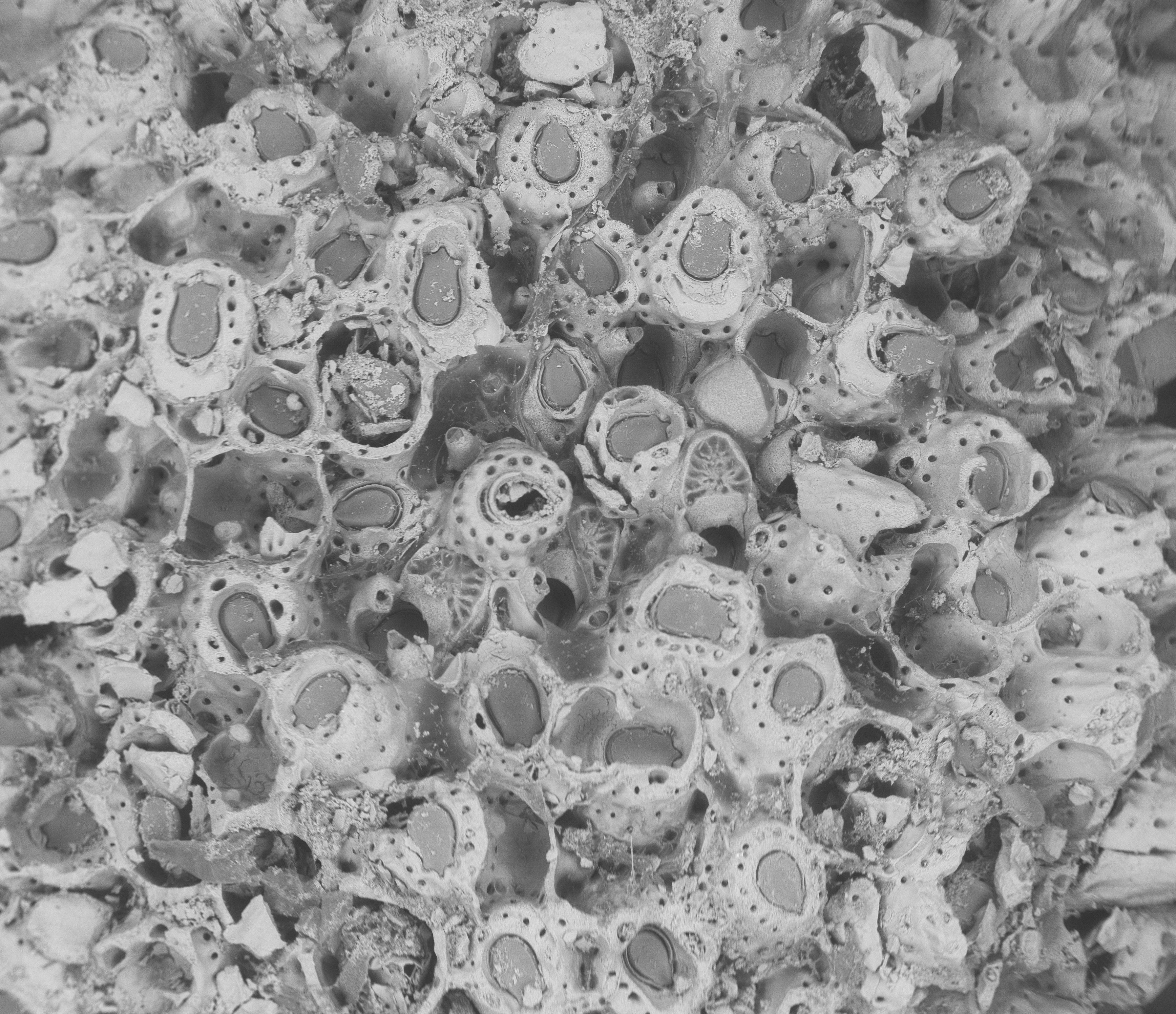MNCN Quaternary and Recent bryozoans
This site displays the diversity of Quaternary and Recent bryozoans kept in the MNCN (Museo Nacional de Ciencias Naturales, National Museum of Natural Sciences of Madrid). It has been created thanks to Synthesys Virtual Access (VA) Call 2, 2021, for the international project Bryozoa Identification Tool (BIT) for Quaternary and Recent Mediterranean and North Atlantic Bryozoans.
Bryozoans are colonial animals that are widely distributed in marine benthic environments and play an important role in temperate and cold-water oceanic shelves as habitat providers. They are one of the most diverse components of intertidal and shelf environment communities. Morphologically and mineralogically diverse, bryozoans are important carbonate producers with an extensive fossil record, which makes them good indicators in environmental and paleoenvironmental research. They are helpful to address evolutionary questions, especially those dealing with the effects of climatic change on assemblages of benthic animals. Existing data, though insufficient, suggests that bryozoans can become a valuable tool in investigating present-day climate change. This project gives the opportunity to reinforce the (1) bryozoan proxy tool in climate research and it will be additionally (2) a basic resource for bryozoan identification through museum collections.

This Project aims to record, on a worldwide map with SEM photographs, all the Quaternary and Mediterranean and North Atlantic Recent bryozoan taxa kept in museums which are participants of the Synthesys Scheme in order to help with bryozoan taxonomic identification. For this, all the specimens are georeferenced and a type specimen or the best specimen of each species has been scanned under scanning electron microscope (SEM). This information is displayed through the own museums’ websites with links to their associated partners on this project (see below participants) and the GBIF Website as well. This project contributes with more than 50 bryozoan taxa not recorded on any Website. It is 3.4% of the current identified taxa from Quaternary and Mediterranean and North Atlantic recent bryozoan taxa.
Although there is already a website (https://www.bryozoa.net/) on recent bryozoan taxa, it includes SEM images of only few taxa and none are georeferenced. This is the first time that Quaternary and Recent bryozoan taxa are georeferenced on a world map and images of the different taxa are displayed. For this, some of the best world museum collections have been used.
Institutions involved in the Synthesys VA Project BIT 2021
NHM, Natural History Museum, London.
MNHN, Museum National d'Histoire Naturelle, Paris.
MNCN, Museo Nacional de Ciencias Naturales, Madrid.
NHMW, Naturhistorisches Museum, Wien.
Naturkunde: Museum fur Naturkunde, Berlin.
NNHC-HUJI, The National Natural History Collections, The Hebrew University of Jerusalem.
It will be an important tool for species identification as the NHM-London keeps at least 215 type specimens (recent), the MNCN 219 type specimens, the MNHN 210 types, NHMW 3 recent syntype series and 3 fossil syntype lots types and Naturkunde fewer than 125 types. Most of them are not available on any other website or repository (only Naturkunde has some of them on GBIF Website, but without SEM images associated). All of the extant specimens are from Mediterranean and North Atlantic and the fossils are worldwide.
The MNCN keeps at least 5157 Quaternary and Recent bryozoan colonies to date. There are at least 395 species. Of these, 81 are holotypes and 211 paratypes belonging to 59 species. There are not less than 24% of the colonies published (1235) in 28 publications.
Follow the link to access MNCN bryozoan data with 691 images.
To cite this project follow this other link
MNCN information on SEM and bibliographical references
Some SEM images have been taken at the Laboratorio de Microscopía electrónica del Servicio de Técnicas No Destructivas del MNCN (FEI INSPECT), by Ana Maria Bravo, Marta Furió and Laura Tormo. Other images have been provided by the authors of the following publications:
ÁLVAREZ, J.A. 1991. La colección de briozoos del Museo Nacional de Ciencias Naturales. Martin, C., & Salvador, A., (eds). Monografías del Museo Nacional de Ciencias Naturales. Museo Nacional de Ciencias Naturales-CSIC, 188 pp.
ÁLVAREZ, J.A. 1992. Briozoos de la Campaña Fauna 1. Parte primera: Ctenostomida y Cheilostomida Anascina. Cahiers de Biologie Marine, 33: 273-297.
ÁLVAREZ, J.A. 1992. Fenestrulina asturiasensis sp. nov. (Bryozoa: Cheilostomida) from the northern coast of the Iberian Peninsula. Journal of the Marine Biological Association of UK, 72: 727-730. http://dx.doi.org/10.1017/S002531540005949X
ÁLVAREZ, J.A. 1992. Sobre algunas especies de la familia Lichenoporidae Smitt, 1866 (Bryozoa, Cyclostomida) en la región Atlántico-Mediterránea: Parte I: género Disporella Gray, 1848. Cahiers de Biologie Marine, 33: 201-243.
ÁLVAREZ, J.A. 1993. Fenestrulina barrosoi sp. nov. (Bryozoa: Cheilostomida) with a review of the Genus Fenestrulina on the Iberian Peninsula. Journal of the Marine Biological Association of the United Kingdom, 73 (4): 831-835.
ÁLVAREZ, J.A. 1993. Sobre algunas especies de la familia Lichenoporidae Smitt, 1866 (Bryozoa, Cyclostomida) en la región Atlántico-Mediterránea. Parte II: estudio preliminar del género Lichenopora Defrance, 1823. Cahiers de Biologie Marine, 34: 261-288.
CREMADES UGARTE, J. 1990. El herbario de algas marinas de Simón de Rojas Clemente y Rubio (1777-1827). Tesis doctoral. Universidad de Santiago.
LÓPEZ DE LA CUADRA, C.M. & J.C. GARCÍA GÓMEZ. 1994. Bryozoa Cheilostomata: the genus Amphiblestrum in the Western Mediterranean and the first Sessibugula of Atlantic waters. Journal of Natural History, 28: 683-693 https://doi.org/10.1080/00222939400770311
LÓPEZ DE LA CUADRA, C.M. & J.C. GARCÍA-GÓMEZ. 1996. The species of Cellaria (Bryozoa: Cheilostomida) with large avicularia from West Africa. Journal of Natural History, 30: 153-161. DOI: 10.1080/00222939600770101
LÓPEZ DE LA CUADRA, C.M. & J.C. GARCÍA GÓMEZ. 1997. Studies on Recent Macroporidae (Bryozoa: Cheilostomatida), with new taxa and ontogeny of the ovicells. Journal of Zoology, 242(4): 605-621.
LÓPEZ DE LA CUADRA, C.M. & J.C. GARCÍA GÓMEZ. 2000. The cheilostomate Bryozoa (Bryozoa: Cheilostomatida) collected by the Spanish 'Antártida 8611' Expedition to the Scotia Arc and South Shetland Islands. Journal of Natural History, 34: 755-772. https://doi.org/10.1080/002229300299408
LÓPEZ DE LA CUADRA, C.M. & J.C. GARCÍA GÓMEZ. 2001. New and little-known ascophoran bryozoans from the Western Mediterranean, collected by the 'Fauna Ibérica' expeditions. Journal of Natural History, 35(11): 1717-1732. https://doi.org/10.1080/002229301317092414
LÓPEZ-FÉ, C.M. 2006. Some bathyal cheilostome Bryozoa (Bryozoa, Cheilostomata) from the Canary Islands (Spain, Eastern Atlantic), with descriptions of three new species, a new genus, and a new family. Journal of Natural History, 40: 1801–1812. https://doi.org/10.1080/00222930601043763
RAMALHO, L.V., C.M. LÓPEZ-FÉ, A. MATEO-RAMÍREZ & J.L. RUEDA. 2020. Bryozoa from deep-sea habitats of the northern Gulf of Cádiz (Northeastern Atlantic). Zootaxa, 4768(4): 451–478. DOI: 10.11646/zootaxa.4768.4.1
RAMALHO, L.V., C.M. LÓPEZ-FÉ & J.L. RUEDA. 2018. Three species of Reteporella (Bryozoa: Cheilostomata) in a diapiric and mud volcano field of the Gulf of Cádiz. with the description of Reteporella victori n. sp. Zootaxa, 4375(1): 090–104. https://doi.org/10.11646/zootaxa.4375.1.4
RAMALHO, L.V., J. A. CABALLERO-HERRERA. J. URRA & J. L. RUEDA. 2020. Bryozoans from Chella Bank (Seco de los Olivos). with the description of a new species and some new records for the Mediterranean Sea. Marine Biodiversity 50: 106. DOI: 10.1007/s12526-020-01119-y
RAMALHO, L.V., R. RODRÍGUEZ-APORTA & S. GOFAS. 2022. Preliminary account on the bryozoans of the Alboran platform (Western Mediterranean). with description of two new species. Zootaxa, 5094(1): 053–091. https://doi.org/10.11646/zootaxa.5094.1.2
REVERTER-GIL, O., J. SOUTO & E. FERNÁNDEZ-PULPEIRO. 2009. Three new species of Iberian cheilostomate Bryozoa. Journal of the Marine Biological Association of the United Kingdom, 89(7): 1499-1506.
REVERTER-GIL, O., J. SOUTO, M. NOVOSEL & K. J. TILBROOK. 2016. Adriatic species of Schizomavella (Bryozoa: Cheilostomata). Journal of Natural History, 50(5-6): 281-321. DOI:10.1080/00222933.2015.1062153
REVERTER-GIL. O. & J. SOUTO, 2021. Two new species of cheilostomate Bryozoa from Iberian waters. European Journal of Taxonomy 760: 16–31. https://doi.org/10.5852/ejt.2021.760.1437
REVERTER-GIL. O., J. SOUTO & E. FERNÁNDEZ-PULPEIRO. 2014. Annotated checklist of Recent marine Bryozoa from continental Portugal. Nova Acta Científica Compostelana (Bioloxía), 21: 1-55.
http://www.usc.es/revistas/index.php/nacc/issue/view/208
REVERTER-GIL. O., J. SOUTO & E. FERNÁNDEZ-PULPEIRO. 2012. A new genus of Lanceoporidae (Bryozoa. Cheilostomata). Zootaxa, 3339:1-29.
SOUTO, J, B. BERNING & A.N. OSTROVSKY. 2016. Systematics and diversity of deep-water Cheilostomata (Bryozoa) from Galicia Bank (NE Atlantic). Zootaxa, 4067(4): 401–459.
SOUTO, J., O. REVERTER-GIL & A.N. OSTROWSKY. 2014. New species of Bryozoa from Madeira associated with rhodoliths. Zootaxa, 3795(2): 135-51. http://dx.doi.org/10.11646/zootaxa.3795.2.3
SOUTO, J., O. REVERTER-GIL & E. FERNÁNDEZ-PULPEIRO. 2010. Gymnolaemate bryozoans from the Algarve (southern Portugal): New species and biogeographical considerations. Journal of the Marine Biological Association of the United Kingdom, 90(7): 1417-1439. DOI:10.1017/S0025315409991640
SOUTO, J., O. REVERTER-GIL & E. FERNÁNDEZ-PULPEIRO. 2010. Bryozoa from detritic bottoms in the Menorca Channel (Balearic Islands, western Mediterranean), with notes on the genus Cribellopora. Zootaxa, 2536: 36-52.
SOUTO, J., O. REVERTER-GIL & H. de BLAUWE. 2015. New and little known species of Celleporina Gray, 1848 (Bryozoa, Cheilostomata) from the Atlantic-Mediterranean region. Journal of the Marine Biological Association of the United Kingdom, 95(04): 723-734. https://doi.org/10.1017/S0025315414001659
SOUTO, J., O. REVERTER-GIL, H. DE BLAUWE, & E. FERNANDEZ‐PULPEIRO. 2014. New records of Bryozoans from Portugal. Cahiers de Biologie Marine, 55: 129‐150.
MNCN staff collaborating on the Synthesys Virtual Access (VA) Call 2021
Synthesys Coordinator:
Begoña Sánchez Chillón
SEM Lab technicians:
Ana Maria Bravo
Marta Furió
Laura Tormo (Lab Manager)
Curators of the collections involved:
Javier Sánchez-Almazán (2006-2023)
Begoña Sánchez Chillón (2012-2015)
Oscar Soriano (1989-1999)
Miguel Villena Sánchez-Valero (2000-2006)
Celia M. Santos Mazorra (2007-present)
GIS Manager:
Victoria González-Cascón
UGID Unit (in English, Computer Management and Digitization Unit)
Manuel Sánchez Ruiz
Museum Photographer:
José María Cazcarra-Barbanoj
External contributors:
Pierre Moissette, National and Kapodistrian University of Athens, has identified the Quaternary specimens.
Lais Vieira Ramalho
Project Coordinator:
Consuelo Sendino
Personal de la colección
Ignacio Doadrio







